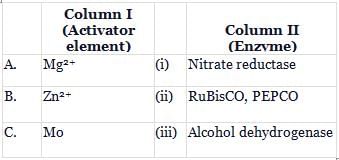Test: Essential Mineral Elements (Old NCERT) - JAMB MCQ
30 Questions MCQ Test Biology for JAMB - Test: Essential Mineral Elements (Old NCERT)
Select the option that contains micronutrients only.
Which of the following are macronutrients?
| 1 Crore+ students have signed up on EduRev. Have you? Download the App |
Micronutrients are present in plant tissues in concentrations less than_____ of dry matter.
The inorganic essential elements which are obtained from the soil are called as
More than ____ elements of the _____ discovered so far are found in different plants.
Which of the following is not one of the three plants macronutrietns included in most fertilisers?
Which of the four most abundant elements in most plants (C, H, O and N), does a terrestrial green plant procure mainly through its roots from the soil?
Minerals which maintain cation-anion balance in cells are
Minerals associated with redox reactions are
Which of the following elements are required for chlorophyll synthesis?
Match Column-l with Column-ll and select the correct option from the codes given below.

Which one of the following essential elements plays an important role in opening and closing of stomata?
Sulphur is constituent of which of the following amino acids?
Deficiency symptoms of readily mobilised essential elements will first appear in ______.
The two elements responsible for splitting of H2O to liberate O2 during photosynthesis are
Phosphorus (P) is a structural element of
Select the incorrectly matched pair.
Chlorosis, i.e., loss of chlorophyll leading to yellowing in leaves, is caused by the deficiency of
Necrosis mainly occurs by the deficiency of
Deficiency of which of the following elements delay flowering in plants?
Select the correct statement regarding manganese toxicity.
Yellowish edges appear in leaves deficient in
The macronutrient______is a component of all organic compounds but is not obtained from soil.
Which of the following is not a deficiency symptom of minerals?
Which of the following minerals activate the enzymes involved in respiration?
Which one of the following helps in absorption of phosphorus from soil by plants?
Premature leaf fall is due to deficiency of
Mineral ion concentration in tissues that reduces the dry weight of tissues by about 10% is considered as
Read the given statements and select the correct option.
Statement 1 : Soil serves as a reservoir of essential elements.
Statement 2 : Soil develops, over the years, through physical and chemical weathering of rocks.
|
224 videos|175 docs|151 tests
|

















